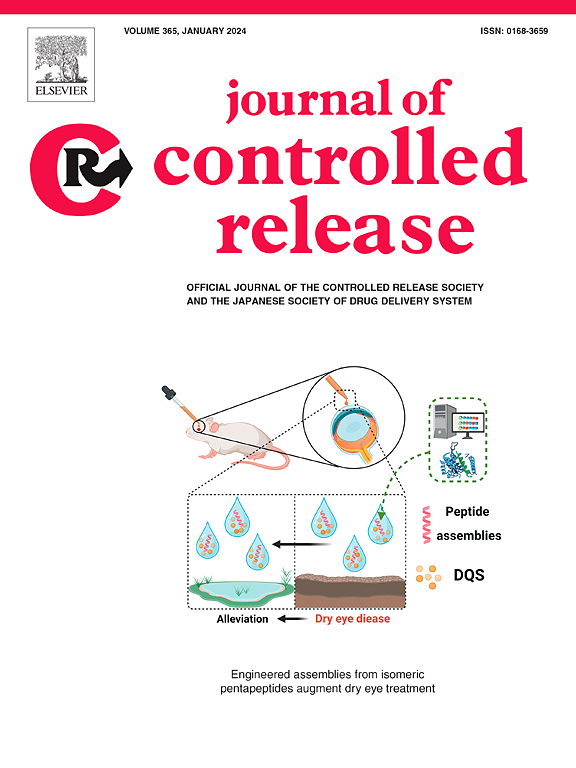可编程分层水凝胶敷料的顺序释放生长因子和dna酶,以加速糖尿病伤口愈合
IF 10.5
1区 医学
Q1 CHEMISTRY, MULTIDISCIPLINARY
引用次数: 0
摘要
生长因子表达失调导致糖尿病足溃疡(DFU)愈合受损。含血小板衍生生长因子(PDGF)凝胶已被临床应用于局部治疗DFU。PDGF刺激中性粒细胞募集,促进DFU创面愈合。然而,高血糖诱导的中性粒细胞过度激活会导致中性粒细胞胞外陷阱(net)的大量产生和长期存在,最终导致意想不到的皮肤损伤和伤口修复延迟。在这里,我们设计了一种分层组装的水凝胶,以实现生长因子PDGF-BB和NET清除剂脱氧核糖核酸酶(DNase) I的局部释放,具有不同的动力学,以增强DFU的愈合。该水凝胶是由抗菌季铵化壳聚糖和次氯酸盐可降解纳米凝胶通过无铜咔嗒反应交联而成,其中PDGF-BB被装载在水凝胶基质中,而DNase I被封装在内部纳米凝胶中。组合疗法的可编程释放是通过水凝胶对伤口微环境的响应来实现的。我们发现,在糖尿病小鼠伤口模型中,共负载PDGF-BB和DNase I的分层水凝胶促进中性粒细胞募集,增加内皮细胞迁移,降解多余的NETs,并防止伤口感染,从而加速伤口愈合。本文章由计算机程序翻译,如有差异,请以英文原文为准。

Programmable hierarchical hydrogel dressing for sequential release of growth factor and DNase to accelerate diabetic wound healing
Dysregulation of growth factor expression causes impaired healing of diabetic foot ulcer (DFU). Platelet-derived growth factor (PDGF)-containing gel has been clinically applied for topical treatment of DFU. Recruitment of neutrophils stimulated by PDGF favors the wound healing of DFU. However, overactivation of neutrophils induced by hyperglycemia causes massive generation and long-term persistence of neutrophil extracellular traps (NETs), ultimately leading to unexpected skin damage and delayed wound repair. Here, we engineer a hierarchically-assembled hydrogel to achieve local release of the growth factor, PDGF-BB and the NET scavenger, deoxyribonuclease (DNase) I with distinct kinetics for enhanced healing of DFU. The hydrogel is constructed by crosslinking of anti-bacterial quaternized chitosan and hypochlorite-degradable nanogel via a copper-free click reaction, in which PDGF-BB is loaded in the hydrogel matrix while DNase I is encapsulated in the inner nanogel. Programmable release of combinatorial therapeutics is implemented by the hydrogel in response to the wound microenvironment. We show that the hierarchical hydrogel co-loaded with PDGF-BB and DNase I promotes neutrophil recruitment, increases endothelial cell migration, degrades excess NETs, and prevents wound infection for accelerating the wound closure in the diabetic mouse wound models.
求助全文
通过发布文献求助,成功后即可免费获取论文全文。
去求助
来源期刊

Journal of Controlled Release
医学-化学综合
CiteScore
18.50
自引率
5.60%
发文量
700
审稿时长
39 days
期刊介绍:
The Journal of Controlled Release (JCR) proudly serves as the Official Journal of the Controlled Release Society and the Japan Society of Drug Delivery System.
Dedicated to the broad field of delivery science and technology, JCR publishes high-quality research articles covering drug delivery systems and all facets of formulations. This includes the physicochemical and biological properties of drugs, design and characterization of dosage forms, release mechanisms, in vivo testing, and formulation research and development across pharmaceutical, diagnostic, agricultural, environmental, cosmetic, and food industries.
Priority is given to manuscripts that contribute to the fundamental understanding of principles or demonstrate the advantages of novel technologies in terms of safety and efficacy over current clinical standards. JCR strives to be a leading platform for advancements in delivery science and technology.
 求助内容:
求助内容: 应助结果提醒方式:
应助结果提醒方式:


